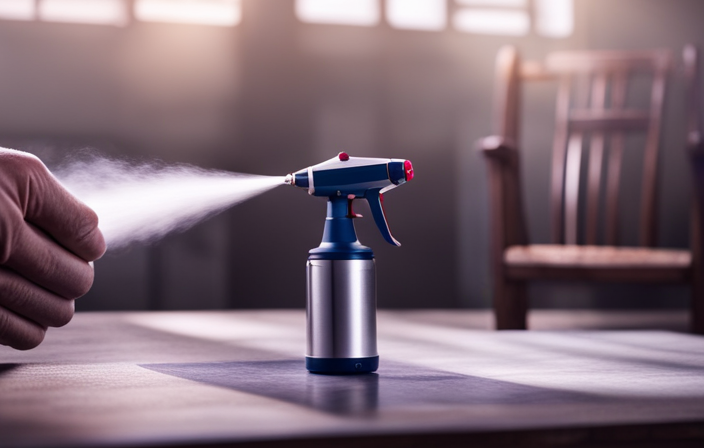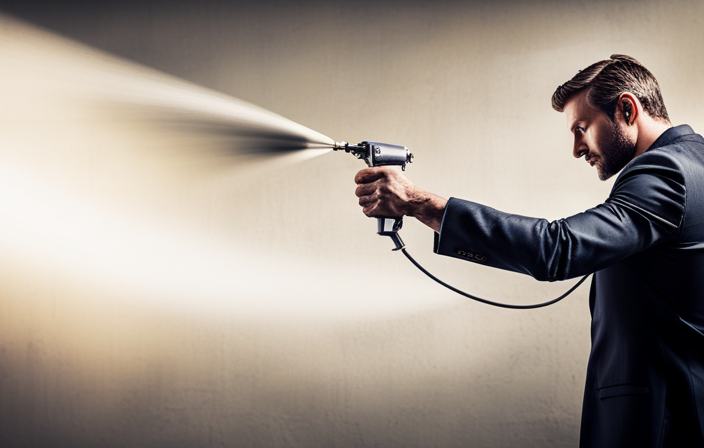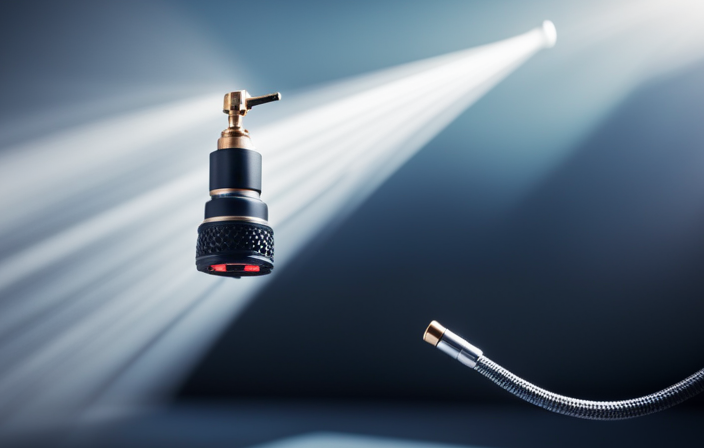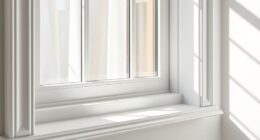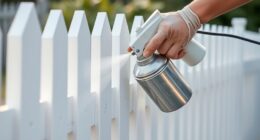Tired of spending countless hours painting furniture, only to end up with messy drips and uneven finishes? Don’t fret! I have discovered a game-changing technique for painting furniture using an airless sprayer, which solves the drip problem. Trust me, it revolutionizes the entire painting process.
In this article, I will guide you through the step-by-step process of achieving flawless results with your airless paint sprayer. From preparing your furniture and choosing the right paint to practicing proper spraying technique and avoiding over-spraying, I will cover it all.
You will learn how to start with light coats of paint, ensuring even coverage by overlapping each stroke. I will also share tips on allowing sufficient drying time and how to clean and maintain your airless paint sprayer for long-lasting performance.
So, get ready to revolutionize your furniture painting game and say goodbye to those pesky drips. Let’s dive in and transform your furniture with ease and precision.
Key Takeaways
- Avoid over-spraying and drips by following proper technique with the airless paint sprayer.
- Allow sufficient drying time between coats for a flawless finish.
- Follow recommended drying techniques from the paint manufacturer regarding temperature, humidity, and ventilation.
- Maintain and clean the airless paint sprayer regularly to prevent clogs and ensure optimal performance.
Prepare Your Furniture for Painting
Get ready to transform your furniture into a work of art with these easy prep tips! Prepping furniture is essential before using an airless paint sprayer. Start by cleaning the furniture thoroughly to remove any dirt or grease that could affect the paint’s adhesion.
Sanding the surface lightly will create a smooth and even base for the paint. Fill any holes or cracks with wood filler and let it dry completely. Consider using the best paint colors that complement your style and décor.
Once the furniture is prepped and ready, it’s time to choose the right paint and equipment for your project. With these prep tips in mind, you’ll be on your way to achieving a flawless finish on your furniture.
Choose the Right Paint and Equipment
Once you’ve carefully selected the ideal type of paint and gathered the necessary equipment, you’re ready to embark on transforming your furniture with the help of an airless paint sprayer, ensuring a flawless finish.
Choosing the right paint color is crucial in achieving the desired look for your furniture. Consider the style and theme of the room where the furniture will be placed, as well as personal preference.
Additionally, proper ventilation is essential when using an airless paint sprayer. Make sure to work in a well-ventilated area, preferably outdoors or in a space with open windows and fans. This will help dissipate fumes and ensure a safe working environment.
With the right paint color and proper ventilation in mind, it’s time to set up a proper painting area for your furniture transformation.
Set Up a Proper Painting Area
To create a harmonious painting experience, find a suitable space where you can set up shop and turn your furniture transformation into a masterpiece. Safety precautions during painting are important, so make sure to wear protective eyewear, gloves, and a mask. Creating a well-ventilated area for painting is crucial to avoid inhaling harmful fumes. Open windows and doors, and use fans to ensure proper airflow. Additionally, place a drop cloth or plastic sheeting on the floor to protect it from paint splatters.
| Safety Precautions | Well-Ventilated Area | Protection for Flooring |
|---|---|---|
| Wear protective eyewear, gloves, and a mask | Open windows and doors for proper airflow | Place a drop cloth or plastic sheeting on the floor |
By following these safety measures and creating a suitable painting area, you can proceed to practice proper spraying technique for your furniture without drips.
Practice Proper Spraying Technique
Master the art of proper spraying technique to achieve flawless results and create a breathtaking transformation for your beloved furniture pieces.
Here are three key elements to consider when practicing proper spraying technique and avoiding paint drips:
-
Maintain a consistent distance: Keep the sprayer nozzle about 8-12 inches away from the furniture surface. This ensures an even application and reduces the chances of drips.
-
Move the sprayer smoothly: Use smooth, steady strokes while spraying. Avoid stopping or starting abruptly, as this can lead to uneven coverage and drips.
-
Overlap each pass: To ensure complete and even coverage, overlap each pass by about 50%. This helps to blend the paint seamlessly and minimizes the risk of drips.
By mastering these techniques, you’ll be well on your way to achieving a flawless finish.
Now, let’s move on to the next step: starting with light coats of paint.
Start with Light Coats of Paint
Begin with a gentle mist of paint, like a delicate whisper, to gradually build up color and create a mesmerizing transformation for your beloved furniture pieces. Applying light coats of paint is crucial to achieving a flawless finish without any drips.
Start by holding the airless paint sprayer about 12 inches away from the furniture’s surface. Move the sprayer in a smooth, sweeping motion, ensuring even coverage across the entire piece. Avoid spraying too much paint at once, as this can lead to drips and uneven application. Instead, apply thin, light coats, allowing each coat to dry before applying the next. This method will help you achieve a smooth, professional-looking finish.
As you move on to the next section about maintaining a consistent distance from the furniture, remember to keep a steady hand and a consistent spraying technique.
Maintain a Consistent Distance from the Furniture
Maintaining a steady hand and a consistent spraying technique will ensure a flawless finish as I glide the mist of color across my treasured furniture pieces, always keeping a uniform distance. To achieve this, it’s crucial to maintain a consistent speed while spraying. Moving too quickly can result in uneven coverage and potential clogging issues, while moving too slowly can lead to drips and pooling of paint. By finding the right balance and maintaining a steady pace, I can prevent these problems and achieve a smooth, professional-looking finish.
As I transition into the next section about overlapping each stroke for even coverage, it’s important to note that this technique will further enhance the overall result by ensuring that every inch of the furniture is evenly coated with paint.
Overlap Each Stroke for Even Coverage
To achieve a flawless finish, make sure to overlap each stroke while maintaining a consistent distance from the furniture, ensuring even coverage and a professional-looking result. The overlap technique is crucial in preventing drips and achieving a smooth finish. As you move the airless paint sprayer across the furniture, imagine dividing it into imaginary sections. Start each stroke slightly before the previous one ends, overlapping by about 50% to ensure complete coverage. This technique eliminates any potential gaps or unevenness in the paint. To help visualize this, imagine a 3 column and 5 row table, where each stroke covers one row and the next stroke overlaps the previous one by one column. This systematic approach guarantees a consistent and drip-free finish. By following this technique, you can avoid over-spraying and drips, ensuring a professional result.
Avoid Over-Spraying and Drips
Avoiding over-spraying and pesky drips is key to achieving a flawless finish when using an airless paint sprayer on your furniture. To avoid clogging issues, it’s important to adjust the spray pattern according to the type of furniture you’re painting. Start by testing the sprayer on a scrap piece of wood or cardboard to make sure the spray pattern is even and not too wide or narrow. If there are any clogs or drips, you may need to adjust the pressure or clean the nozzle.
Additionally, maintain a consistent distance from the furniture while spraying to avoid over-spraying and causing drips. This’ll help ensure an even application of paint without any unwanted marks or streaks. By avoiding over-spraying and drips, you’ll be on your way to achieving a professional-looking finish.
Moving on to the next section, it’s important to allow sufficient drying time for the paint to cure properly.
Allow Sufficient Drying Time
Now that we’ve discussed the importance of avoiding over-spraying and drips when using an airless paint sprayer on furniture, let’s move on to the next crucial step: allowing sufficient drying time.
This is a crucial aspect of achieving a flawless finish without any paint build-up or imperfections. To ensure proper drying, it’s essential to follow the recommended drying techniques provided by the paint manufacturer.
These techniques may include factors such as temperature, humidity, and ventilation. Additionally, it’s crucial to allow each coat of paint to dry completely before applying the next one. By doing so, you’ll prevent any paint build-up or excessive layers that could lead to drips or unevenness.
Now that we’ve covered proper drying techniques and preventing paint build-up, let’s move on to the next section about how to clean and maintain your airless paint sprayer.
Clean and Maintain Your Airless Paint Sprayer
Ensure you regularly cleanse and care for your air-powered paint applicator to maintain its optimal performance. Cleaning your airless paint sprayer after each use is essential to prevent clogs and ensure smooth operation.
Start by flushing out any remaining paint by running a cleaning solution through the sprayer. Use a brush or cloth to remove any dried paint or debris from the nozzle, gun, and filters. Pay extra attention to the filters, as they can easily become clogged and affect the spray pattern.
Additionally, inspect the hoses and connections for any leaks or damage. Troubleshoot common issues such as inconsistent spray pattern or loss of pressure by checking for loose connections, worn seals, or obstructions in the nozzle.
Regular maintenance and cleaning will extend the lifespan of your airless paint sprayer and ensure flawless results every time.
Frequently Asked Questions
Can I use an airless paint sprayer on any type of furniture surface?
Using an airless paint sprayer on furniture surfaces has its pros and cons. It allows for fast and even coverage, but it may require more prep work and can create overspray. To achieve a smooth finish, make sure to sand and clean the furniture beforehand and practice with the sprayer on a test surface.
How long should I wait before applying additional coats of paint with an airless paint sprayer?
I usually wait about 2 hours between coats when using an airless paint sprayer. It’s important to let each coat dry properly before applying the next one. Typically, 2-3 coats are necessary for a smooth and even finish.
Is it necessary to sand the furniture before using an airless paint sprayer?
Sanding is necessary before using an airless paint sprayer on furniture. It helps to smooth the surface, remove imperfections, and ensure proper adhesion of the paint.
Can I use water-based paint with an airless paint sprayer?
Yes, you can use water-based paint with an airless paint sprayer. It’s important to properly thin the paint and adjust the sprayer settings. Tips for achieving a smooth finish include using light, even strokes and maintaining a consistent distance from the surface.
What safety precautions should I take when using an airless paint sprayer on furniture?
When using an airless paint sprayer on furniture, safety precautions are crucial. To prevent paint drips, wear protective clothing, goggles, and a respirator. Create a well-ventilated area and cover surrounding surfaces.
Conclusion
In conclusion, using an airless paint sprayer on furniture without drips is a skill that can be mastered with practice and the right techniques.
By preparing your furniture properly, choosing the right paint and equipment, and setting up a proper painting area, you can achieve a flawless finish.
Remember to practice proper spraying technique, starting with light coats of paint and overlapping each stroke for even coverage. Avoid over-spraying and drips by maintaining a steady hand and allowing sufficient drying time.
By following these steps and regularly cleaning and maintaining your airless paint sprayer, you can transform your furniture into beautiful pieces that will impress anyone who sees them.
So go ahead, give it a try and see the amazing results for yourself!
